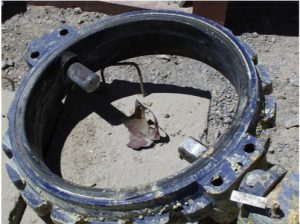Author: CGIS (CG Industrial Specialties)
While there are many benign chemicals (water is a chemical), many chemical manufacturing processes and the chemicals that are used and produced are dangerous. They can be toxic, explosive, aggressively trying to combine with another chemical, or corrosive. These chemicals need containment and management so that they are not released where their properties can do damage or be lost to the downstream process for which they are chosen.
If we look at containment and the purpose of the valve is isolation, we need to think about resistance to corrosion from the process fluid. Design codes like ASME B16.34 provide operating pressure and temperature limits for each pressure Class at various operating temperatures for categories of materials. For example, valves of ASME Standard Class 300 for Group 2.2 materials, consisting of several grades of stainless steels including the common forged and wrought 316 and cast CF8M, have a working pressure by Class in psig at a range of temperature. A Class 300 valve of this material operating between -29°C to 38 °C, has a 720-psig pressure limit, the valve’s maximum allowable working pressure (MAWP).
In order to meet that working pressure the manufacturer will produce a valve body with a minimum body wall thickness. This wall thickness will be thicker than necessary to add a safety margin. In the factory testing, this extra safety is proved by pressurizing the body 50% beyond the maximum allowable working pressure during its factory hydro test.
If the corrosion begins to reduce the wall thickness either evenly or in discrete pockets or sections, the valve becomes vulnerable to loss of containment. When referring to the Sulphuric Acid Isocorrosion chart below, you will find lines depicting less than or equal to 20 MPY (milli-inch or mils per year) corrosion. Note how alloy CF8M is only suitable for very weak or very strong acid at low temperatures and alloy CD4MCu disappears from suitability while two others that were in the same suitable category remain for a range of
higher temperatures.
Respecting the overall piping system’s corrosion allowance, often expressed as x mpy, you generally select valves with a trim (the sealing parts) that have less than 1 mpy corrosion rating while the body would have less than 20 mpy. This practice leads to examining the body wall thickness during the time one examines the piping. Some SSVs applications would demand a lower corrosion allowance, based on the severity of an upset, the time period between maintenance turnarounds or minimum process runs.
SSVs in the Pulp & Paper industry
In the Pulp and Paper industry, chemicals for bleaching the pulp have evolved from chlorine into less dangerous chlorine dioxide, sodium hypochlorite or hydrogen peroxide. For the Kraft Pulp process, cost efficiencies have encouraged the mills to create the necessary chemicals required on-site in a plant within a plant called Chem Prep. One process within this sub-plant can produce the bleaching agent – chlorine dioxide.
Chlorine dioxide can be made by reducing sodium chlorate in a strong acid (sulphuric or hydrochloric) solution and a reducing agent like methanol, hydrogen peroxide or sulfur dioxide. The basic production route is: chlorate + acid + reducing agent → chlorine dioxide + by-products. A commercially important production route uses methanol as the reducing agent and sulfuric acid for the acidity. Advantages of not using chloride-based processes are two-fold; the formation of elemental chlorine is eliminated, and sodium
sulfate, a valuable chemical for the pulp mill, is a side-product.
It was this early focus on a chemical process and exposure to several corrosive chemicals that paved the way for our future specialization in SSVs. We gained the confidence to challenge an even wider range of chemicals and chemical processes, exposing us to a range of materials including titanium, super alloys (Inconels and Hastelloys), and fluorocarbons like PVDF and PTFE.





